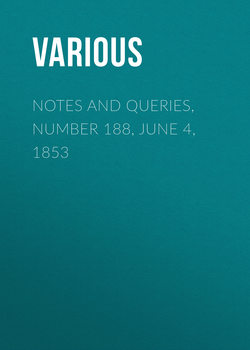Читать книгу Notes and Queries, Number 188, June 4, 1853 - Various - Страница 6
Notes
SHAKSPEARE CORRESPONDENCE
ОглавлениеShakspearian Drawings.—I have very recently become possessed of some curious drawings by Hollar; those relating to Shakspeare very interesting, evidently done for one Captain John Eyre, who could himself handle the pencil well.
The inscription under one is as follows, in the writing of the said J. Eyre:
"Ye house in ye Clink Streete, Southwarke, now belonging to Master Ralph Hansome, and in ye which Master Shakspeare lodged in ye while he writed and played at ye Globe, and untill ye yeare 1600 it was at the time ye house of Grace Loveday. Will had ye two Rooms over against ye Doorway, as I will possibly show."
Size of the drawing, 12 × 7, "W. Hollar delin., 1643." It is an exterior view, beautifully executed, showing very prominently the house and a continuation of houses, forming one side of the street.
The second has the following inscription in the same hand:
"Ye portraiture of ye rooms in ye which Master Will Shakspeare lodged in Clink Streete, and which is told to us to be in ye same state as when left by himself, as stated over ye door in ye room, and on the walls were many printed verses, also a portraiture of Ben Jonson with a ruff on a pannel."
Size of the drawing 11⅝ × 6⅞, "W. Hollar delin., 1643:" shows the interior of three sides, and the floor and ceiling, with the tables, chairs, and reading-desk; an open door shows the interior of his sleeping-room, being over the entrance door porch.
The third—
"Ye Globe, as to be seen before ye Fire in ye year 1615, when this place was burnt down. This old building," &c.
Here follows a long interesting description. It is an exterior view; size of drawing 7¼ wide × 9⅞ high, "W. H. 1640."
The fourth shows the stage, on which are two actors: this drawing, 7⅞ × 6½, was done by J. Eyre, 1629, and on which he gives a curious description of his accompanying Prince Charles, &c.; at this time he belonged to the Court, as he also accompanied that prince to Spain.
The fifth, done by the same hand in a most masterly manner, pen and ink portrait of Shakspeare, copied, as he writes, from a portrait belonging to the Earl of Essex, with interesting manuscript notice.
The sixth, done also by J. Eyre:
"Ye portraiture of one Master Ben Jonson, as on ye walls of Master Will Shakspeare's rooms in Clinke Streete, Southwarke."—J. E. 1643.
The first three, in justice to Hollar, independent of the admirers of the immortal bard and lovers of antiquities, should be engraved as "Facsimiles of the Drawings." This shall be done on my receiving the names of sixty subscribers, the amount of subscription one guinea, for which each subscriber will receive three engravings, to be paid for when delivered.
P. T.
P. S.—These curious drawings may be seen at No. 1. Osnaburgh Place, New Road.
Thomas Shakspeare.—From a close examination of the documents referred to (as bearing the signature of Thomas Shakspeare) in my last communication to "N. & Q.," Vol. vii., p. 405.), and from the nature of the transaction to which they relate, my impression is, that he was by profession a money scrivener in the town of Lutterworth; a circumstance which may possibly tend to the discovery of his family connexion (if any existed) with William Shakspeare.
Charlecote.
Passage in Macbeth, Act I. Sc. 5.—
" · · · Come, thick night,
And pall thee in the dunnest smoke of hell,
That my keen knife see not the wound it makes,
Nor heaven peep through the blanket of the dark,
To cry, Hold, hold!"
In Mr. Payne Collier's Notes and Emendations, p. 407., we are informed that the old corrector substitutes blankness for blanket. The change is to me so exceedingly bad, even if made on some sort of authority (as an extinct 4to.), that I should have let it be its own executioner, had not Mr. Collier apparently given in his adhesion to it. I now beg to offer a few obvious reasons why blanket is unquestionably Shakspeare's word.
In the Rape of Lucrece, Stanza cxv., we have a passage very nearly parallel with that in Macbeth:
"O night, thou furnace of foul reeking smoke,
Let not the jealous day behold thy face,
Which underneath thy black all-hiding cloak,
Immodestly lies martyr'd with disgrace."
In Lucrece, the cloak of night is invoked to screen a deed of adultery; in Macbeth the blanket of night is invoked to hide a murder: but the foul, reeking, smoky cloak of night, in the passage just quoted, is clearly parallel with the smoky blanket of night in Macbeth. The complete imagery of both passages has been happily caught by Carlyle (Sartor Resartus, 1841, p. 23.), who, in describing night, makes Teufelsdröckh say:
"Oh, under that hideous coverlet of vapours, and putrefactions, and unimaginable gases, what a fermenting-vat lies simmering and hid!"
C. Mansfield Ingleby.
Birmingham.
"Discourse of Reason" (Vol. vii., p. 497.).—This phrase, "generally supposed to be peculiarly Shakspearian," which A. E. B. has indicated in his quotation from Philemon Holland, occurs also in Dr. T. Bright's Treatise of Melancholy, the date of which is 1586. In the third page of the dedicatory epistle there is this sentence:
"Such as are of quicke conceit, and delighted in discourse of reason in naturall things."
Here, then, is another authority against Gifford's proposed "emendation" of the expression as it occurs in Hamlet.
M. D.
